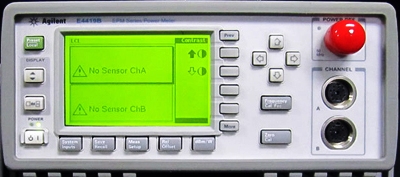
|
|
The Agilent E4419B is a high-performance, dual-channel, programmable power meter. It is fully compatible with the 8480 series of power sensors and the new E series of power sensors. Depending upon which sensor is used, the E4419B can measure from -70 dBm to +44 dBm at frequencies from 9 kHz to 110 GHz. Designed for bench and automatic test equipment use (ATE), the E4419B makes fast (up to 100 readings per second with E-series sensors), accurate and repeatable power measurements. The E4419B is a true dual-channel power meter, which means that you get two simultaneous power readings on the display. The E4419B power meter has a high-resolution LCD display with LED backlighting and contrast control. This allows users to see the power readings from a distance, at a wide viewing angle and in a variety of lighting conditions. Users can display both the digital and analog types of readout on the meter’s split screen facility. The analog peaking meter allows users to make accurate adjustments. Specifications. Frequency Range: 9 kHz to 110 GHz, sensor dependent. Power Range: -70 dBm to +44 dBm (100 pW to 25 W), sensor dependent. Power Sensors: Compatible with all 8480 series and E-series sensors. Single Sensor Dynamic Range: 90 dB maximum (E-series sensors), 50 dB maximum (8480 series sensors). Display Units: Absolute; Watts or dBm, Relative; Percent or dB. Display Resolution: Selectable resolution of 1.0, 0.1, 0.01, and 0.001 dB in log mode, or 1 to 4 digits in linear mode. Default Resolution: 0.01 dB in log mode, 3 digits in linear mode. Instrumentation Accuracy Absolute: ± 0.02 dB (log) or ± 0.5% (linear), add the corresponding power sensor linearity percentage. Instrumentation Accuracy Relative: ± 0.04 dB (log) or ± 1.0% (linear), add the corresponding power sensor linearity percentage. Power Reference Output: 1.00 mW (0.0 dBm). Factory set to ± 0.7%, traceable to the U.S. National Institute of Standards and Technology (NIST). Power Reference Accuracy: ± 1.2% worst case (± 0.9% rss) for one year. Option 001, supplies an internal rechargeable battery providing full instrument functionality when access to an ac power outlet is not available. Option 002, supplies parallel rear panel sensor input(s). The power reference oscillator output is on the front panel. Option 003, supplies parallel rear panel sensor input(s). The power reference oscillator output is also on the rear panel. Option 004, deletes the Agilent 11730A sensor cable(s) provided.
|